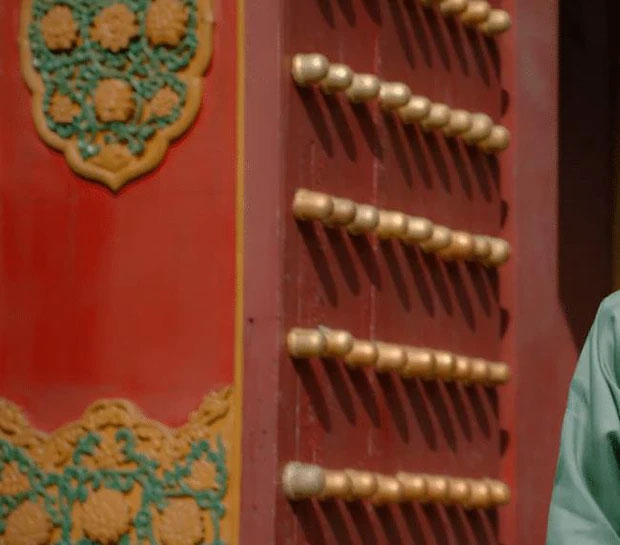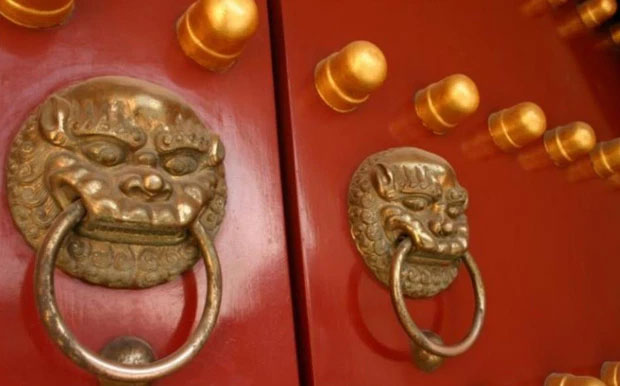Anyone who has visited the Forbidden City or knows it through films and television series is aware that one of the structures has many “bumpy marks” on its doors. Many people are curious about what these rough patches are and what purpose they serve. Moreover, what intrigues people the most is the prohibition against touching them. What is the mystery behind this?
Origin of the “Bumps”
Today, due to changes in lifestyle, most houses in China no longer feature gates like those of the Forbidden City. However, in ancient times, this detail was quite common; it was not only found on palace gates but also on the gates of wealthy households. The ancients referred to them as “door nails.”
Contrary to what many might imagine, these nails were not originally designed for aesthetic purposes but had a practical significance. In ancient times, raw materials for construction were limited, and the doors of each household were made of wood.
At that time, there were no composite boards or large trees, so people could only join small pieces of wood together to create a large panel. In the case of the Forbidden City’s gates, due to their large size, many pieces of wood had to be assembled together.
During this process, carpenters had to use wooden nails. In some cases, they even had to use ropes threaded through to ensure the doors were securely and beautifully joined.

Ancient people used round-headed objects to cover the protruding nails to prevent injuries. (Illustration: Sohu)
However, this joining method had a limitation: the heads of the wooden nails would be exposed. Since the heads were sharp, people’s hands would accidentally get scratched when opening the doors. Moreover, the exposed wooden nails were not aesthetically pleasing, prompting the ancients to devise a solution.
They used round-headed objects to cover the protruding nails to prevent injuries. Initially, it was Lu Ban who conceived this idea and applied it in practice. As a result, the “door nails” were born. Originally made of wood, they could not withstand wear and tear over time and were prone to damage.
Later, Mozi improved and upgraded wooden door nails to bronze ones. Subsequently, bronze door nails gradually became popular. The nails on the gates of the Forbidden City that we see today are also bronze nails.
Door Nails – A Symbol of Authority
Originally, the door nails were merely ordinary objects, representing the wisdom of the laboring people of the past. However, during the Qing Dynasty, these nails took on a different meaning and became a symbol of “feudal status.”
In ancient times, the hierarchy was very strict, with the emperor being the most respected and holding the highest position, followed by officials, and then commoners, with status diminishing accordingly. The emperor of the Qing Dynasty regarded these nails as symbols of authority and established regulations regarding their use.

The emperor of the Qing Dynasty regarded these nails as symbols of authority.
For example, the Qing Dynasty stipulated that only the emperor’s gate could use 81 door nails, including 9 horizontal and 9 vertical nails. The gates of princely residences could only use 49 door nails, with 7 horizontal and 7 vertical. The number would decrease according to rank. Anyone who dared to violate this would face severe punishment.
Additionally, door nails not only served to signify rank but also carried connotations of prosperity. In popular belief, the door nails on the Forbidden City are even more special because they embody the aura of royalty and have the power to ward off evil spirits.
Records from some scholars during the Qing Dynasty mention that during the annual Lantern Festival, people would gather at the palace gates to touch the nails on the doors of the Forbidden City, hoping for good luck and to dispel misfortune.
This was the only occasion when the emperor allowed the public to touch the door nails, leading some individuals to travel thousands of miles just to touch the nails on the gates of the Forbidden City.
At that time, commoners had the opportunity to touch them only once a year, so it did not have a significant impact. Furthermore, these nails were also replaced annually to maintain their aesthetic appeal.
Today, No One is Allowed to Touch
However, with the development and changes in history and society, regulations have changed significantly. Many tourists have heard about the lucky door nails and wish to touch them when visiting the Forbidden City.

Due to the high number of visitors, the management had to implement measures to protect them. (Photo: GOV).
Over time, the nails on the gates have endured over 600 years of changes in the Forbidden City. They are now classified as a national cultural relic and are strictly protected. Therefore, visitors can no longer touch them as freely as before.
Moreover, the Forbidden City is a site with an extremely high volume of foot traffic. Just one light touch from each visitor could easily wear down these nails. Some argue that if they get damaged, they can be replaced, but how can historical relics ever be substituted?
Thus, to prevent damage to the door nails, the management of the Forbidden City has devised a method to protect all the door nails with a glass cover. Since then, neither tourists nor anyone else has been allowed to touch these nails anymore.


















































